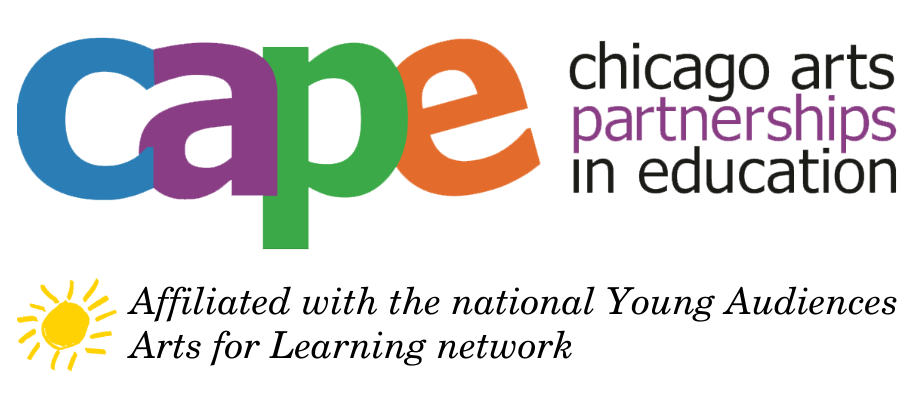CAPE Classrooms: Students learn what it’s like to have no access to clean drinking water- what happens next is amazing…
CAPE Classrooms is our series highlighting great work from our programs across Chicago.
It was a typical day at North-Grand High School. Between periods, the intercom played lively music while students shuffled from one class to another. However, when the 10th grade Honors World Studies class arrived in Michelle Livas’s classroom, there was a surprise waiting for them.
On each desk was a plastic cup. Sitting down, some students found that the water inside their cup was murky, greenish, and had a strange odor. None of these students dared to drink this water, and some of them became upset because they noticed that other students in the class had clean water in their cups.
“How come they get clean water?!”
A student with clean drinking water shrugged his shoulders.
Another student chimed in, “Hey at least you got water, my cup’s empty. Why are these cups on our desks?”
Confusion ensued as long-time co-teachers in the Veteran Partnerships Program, Michelle, the classroom teacher, and Jessi Walsh, the CAPE teaching artist smirked at one another and observed as their students grappled with this unfair scenario. Students started to ask questions about the meaning of this strange exercise, and Jessi told them, “Our answers to your questions are not meaningful yet. We want you to tell us what this means.” Michelle wrote their ideas on the board.
One student tried to make sense of Jessi’s comment, “So, like, the deeper our questions get, the more meaningful your answers will be?”
Students continued to guess at why their teachers would put contaminated water on their desks until Jessi offered a bit of resolution. “What just happened here, what we set on your desks, and the conversation you just had: we just made art. That feeling like you want to know, like you have more questions- that is part of art making.”
Arts integration doesn’t have to be as explicit as, say, using modern dance to teach kids about how tornadoes work. It doesn’t have to limit itself to purely one creative discipline plus one academic topic.  In Jessi and Michelle’s class, the students are investigating the politics of water– a huge topic that includes teaching about government, economics, history, health, climate change, etc.- by creating interactive multiplayer games. Jessi’s personal multidisciplinary arts practice (http://www.jessitwalsh.com/index.html) involves conceptualizing interactive experiences, performing in public spaces, and collaborative art making, all of which directly contribute to the students’ own success in Jessi and Michelle’s projects.
In Jessi and Michelle’s class, the students are investigating the politics of water– a huge topic that includes teaching about government, economics, history, health, climate change, etc.- by creating interactive multiplayer games. Jessi’s personal multidisciplinary arts practice (http://www.jessitwalsh.com/index.html) involves conceptualizing interactive experiences, performing in public spaces, and collaborative art making, all of which directly contribute to the students’ own success in Jessi and Michelle’s projects.
Teachers and artists who have worked together for multiple years get really good at experimentation during the course of their classroom projects– they are often learning right alongside their students, minimizing the traditional classroom hierarchies between teachers and students. Arts integration can be messy in any and every sense, but engaging in that kind of messiness creates so many surprising opportunities for students and teachers alike to more deeply engage with the subject matter, the art making, and each other.
(Learn more about CAPE’s approach to arts integration)
In the classroom sessions that followed that initial, confusing day, Jessi and Michelle built out from the “dirty water, clean water experience” to engage their students in dialogue and research about the value of water, human rights issues related to water, and the economic realities connected to global water supplies. They asked students to research water issues and create games: “We’re not asking you to save the world, we want you to think about the questions you are asking the players of the game.”
Students competed with each other in games created by the instructors and games they created themselves- each game a performative demonstration of the content they were exploring vis a vis water politics.
Above, students embark on a “Three Legged Water Race” where they must save their precious water held precariously above their heads while they are literally tied together and therefore dependent on one another. Below, a student explains to Jessi how they’re trying to conceptualize their game and who controls water on different continents.
By the end of the project, students in Michelle and Jessi’s class developed a much deeper understanding of the global struggles for clean water and similar necessities for life. Michelle and Jessi enjoyed the project as much as their students did, and we asked them what they loved most:
Michelle:
“I love introducing students to Jessi and watching their curiosity unfold as they try to understand her perspective. I have two overall favorite parts of this project:
- The day we did the impromptu water game to introduce the IDEA of a game about water politics. Running through the hallways, throwing paper balls, watching them carefully balance cups of water and try to work as teams, seeing them enjoy the freedom of action outside of the classroom, and hearing their observations and reactions was priceless. Also seeing the looks on their faces as they realized the possibilities of the project/game.
- On the hectic last day, when students were pressed for time and missing key members of their team, two young men took to the white board to sketch out a game of probability involving water access. It was off the cuff and AMAZING. They were like machines; scheming and collaborating and working feverishly towards their deadline. Observing their thought process was incredible.”
Jessi:
“My favorite part of this project was actually working with our program’s incredible time crunch. Michelle and I discussed how much information to give and how much to retain for each class day and made some compromises. Citing my own aversion to artwork which is “too easy” and “gives you all the answers” (No fun at all! How can the audience engage, how can they learn and grow? I’m a firm believer that successful, invigorating, inclusive artwork creates enough room for the audience to wiggle around in.), we wanted to make sure that the driving tension to research and discover was a healthy and energized one in the classroom. We especially wanted to reassure them that, even though we don’t have a whole lot of time, we are a safe space for each other to bounce seemingly wild ideas off of– and that, yes, making work under very tight deadlines is a different kind of magic, and makes for very unique work, indeed.
As a result, and despite (perhaps because of) the time crunch, our students made high quality, thorough and in-depth water politics projects formed from a nice balance of curious, think-y research and innovative, experimental action in order to deliver the content to their audience in a fun and participatory manner.”







